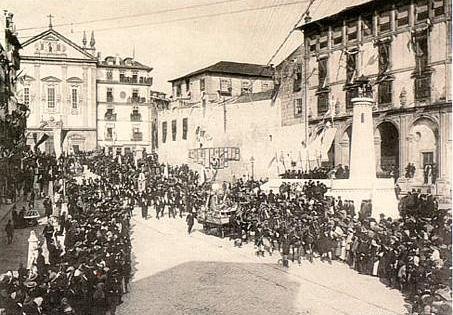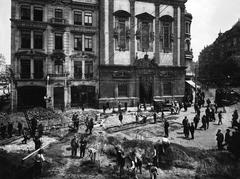
Visiting Banco Nacional Ultramarino in Porto: Hours, Tickets, and History
Date: 19/07/2024
Introduction
Nestled in the heart of Porto, Portugal, the Banco Nacional Ultramarino (BNU) stands as a monumental testament to the nation’s rich banking history and colonial past. Established in 1864, BNU played an instrumental role in the economic development of Portugal’s overseas territories, providing essential financial services that facilitated trade and integration into the global economy. This comprehensive guide delves into the intricate history, architectural splendor, and cultural significance of BNU, offering valuable insights for visitors keen on exploring this historical landmark. With its blend of neoclassical and modernist architectural styles, BNU serves as both a financial institution and a cultural beacon that has impacted the social fabric of Porto. Whether you are a history aficionado, architecture enthusiast, or simply a curious traveler, this guide will equip you with all the necessary information to make the most of your visit to Banco Nacional Ultramarino. For further historical context, the official website of Caixa Geral de Depósitos provides a detailed account of BNU’s legacy.
Table of Contents
- [Exploring the History and Significance of Banco Nacional Ultramarino in Porto](#exploring-the-history-and-significance-of-banco-nacional-ultramarino-in-portoexploring-the-history-and-significance-of-banco-nacional-ultramarino-in-porto)
- [Founding and Early Years](#founding-and-early-yearsfounding-and-early-years)
- [Expansion into Porto](#expansion-into-portoexpansion-into-porto)
- [Role in the Portuguese Colonial Empire](#role-in-the-portuguese-colonial-empirerole-in-the-portuguese-colonial-empire)
- [Nationalization and Modernization](#nationalization-and-modernizationnationalization-and-modernization)
- [Merger and Legacy](#merger-and-legacymerger-and-legacy)
- [Architectural and Cultural Impact](#architectural-and-cultural-impactarchitectural-and-cultural-impact)
- [Architectural Significance](#architectural-significancearchitectural-significance)
- [Cultural Impact](#cultural-impactcultural-impact)
- [Visitor Information](#visitor-informationvisitor-information)
- [Visiting Hours](#visiting-hoursvisiting-hours)
- [Tickets](#ticketstickets)
- [Location](#locationlocation)
- [Nearby Attractions](#nearby-attractionsnearby-attractions)
- [Travel Tips](#travel-tipstravel-tips)
- [FAQ](#faqfaq)
- [Conclusion](#conclusionconclusion)
- [References](#referencesreferences)
Exploring the History and Significance of Banco Nacional Ultramarino in Porto
Founding and Early Years
The Banco Nacional Ultramarino (BNU) was established on December 16, 1864, in Lisbon, Portugal. The bank was founded with the primary objective of supporting Portugal’s overseas territories, which at the time included vast colonies in Africa, Asia, and South America. The creation of BNU was a strategic move to facilitate economic development and trade within these colonies, providing financial services that were crucial for their growth and integration into the global economy.
Expansion into Porto
The expansion of BNU into Porto, Portugal’s second-largest city, was a significant milestone in the bank’s history. Porto, known for its rich maritime history and as a hub of commerce and industry, was an ideal location for BNU to extend its services. The bank’s presence in Porto helped to bolster the local economy by providing essential banking services to businesses and individuals alike. This expansion was part of a broader strategy to establish a robust banking network across Portugal and its colonies.
Role in the Portuguese Colonial Empire
BNU played a pivotal role in the financial administration of Portugal’s colonial empire. The bank issued currency in several Portuguese colonies, including Angola, Mozambique, Macau, and Timor. This function was critical in standardizing the monetary systems within these territories, facilitating trade, and ensuring economic stability. The issuance of currency by BNU also underscored the bank’s importance as a financial institution that extended beyond the borders of mainland Portugal.
Nationalization and Modernization
In 1974, following the Carnation Revolution, which led to the fall of the Estado Novo regime and the subsequent decolonization process, BNU underwent significant changes. The bank was nationalized as part of a broader wave of nationalizations that affected many sectors of the Portuguese economy. This period marked a transition for BNU as it adapted to the new political and economic landscape of post-colonial Portugal.
Merger and Legacy
In 2001, BNU merged with Caixa Geral de Depósitos (CGD), Portugal’s largest state-owned banking group. This merger was part of a strategic consolidation within the Portuguese banking sector aimed at creating a more robust and competitive financial institution. Despite the merger, the legacy of BNU continues to be recognized, particularly in its historical role in supporting Portugal’s overseas territories and its contributions to the country’s economic development.
Architectural and Cultural Impact
Architectural Significance
The BNU building in Porto is significant for both its historical role and its architectural value. The building is an example of early 20th-century architecture, reflecting the grandeur and ambition of the period. Visitors to the BNU building in Porto can appreciate its architectural details, which include ornate facades and grand interiors that speak to the bank’s prestigious status during its operational years.
Cultural Impact
BNU’s influence extended beyond the financial sector, impacting the cultural and social fabric of the regions it served. In Porto, the bank supported various cultural initiatives and community projects, contributing to the city’s cultural heritage. The bank’s involvement in these activities helped to foster a sense of community and civic pride among the residents of Porto.
Visitor Information
Visiting Hours
The BNU building is not typically open to the public, but its exterior can be admired at any time. Check with local tour guides for any special access.
Tickets
There are no tickets required to view the exterior of the BNU building.
Location
The BNU building is located in the heart of Porto’s historic center, making it easily accessible on foot.
Nearby Attractions
While visiting BNU, explore nearby attractions such as the Clerigos Tower, Livraria Lello, and Porto Cathedral.
Travel Tips
- Wear comfortable walking shoes as Porto’s historic center is best explored on foot.
- Don’t forget your camera to capture the architectural beauty of the BNU building and surrounding sites.
FAQ
Q: Is Banco Nacional Ultramarino open to the public?
A: The BNU building is not typically open to the public, but its exterior can be admired as part of a walking tour of Porto’s historic center.
Q: What are the visiting hours for Banco Nacional Ultramarino?
A: The building’s exterior is accessible at any time. For special access, check with local tour guides.
Q: Are there any guided tours available?
A: Local tour guides may offer special tours that include the BNU building. Check with tour operators for details.
Conclusion
The history of Banco Nacional Ultramarino is a testament to its pivotal role in the economic and cultural development of Portugal and its overseas territories. From its founding in 1864 to its merger in 2001, BNU’s legacy continues to be felt in Porto and beyond. For those interested in the history of banking and colonial economics, a visit to the BNU building in Porto offers valuable insights into this fascinating chapter of Portuguese history. Don’t forget to check out other historical sites in Porto to make the most of your visit. For additional information on visiting hours, guided tours, and more, the Porto Walkers website is an excellent resource.







































